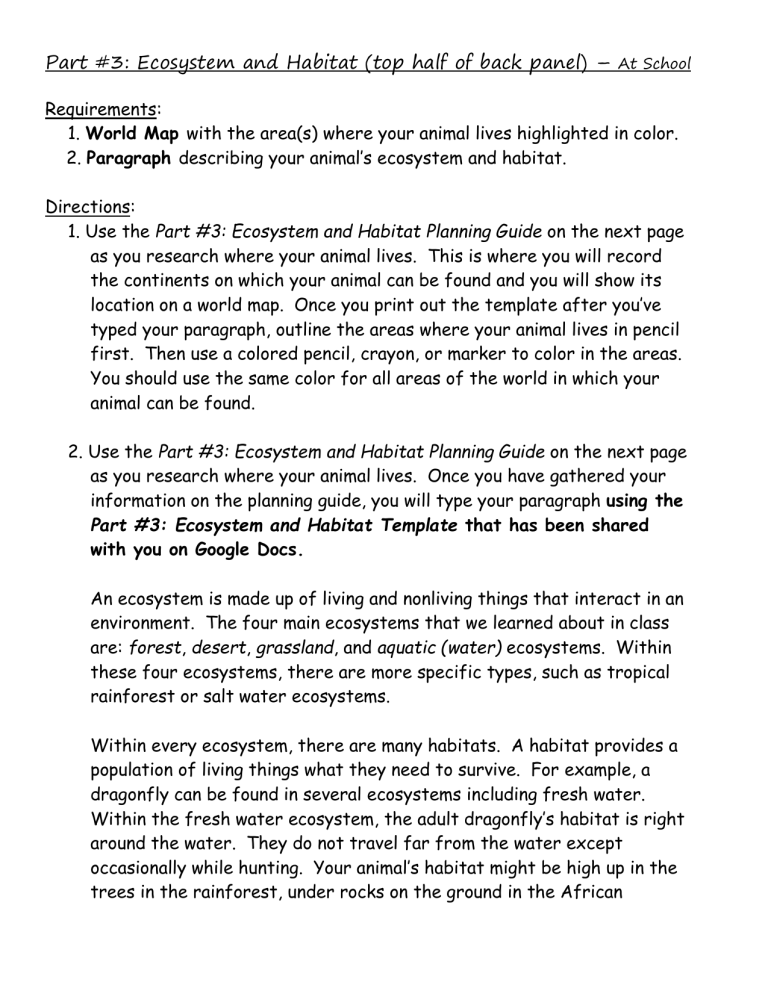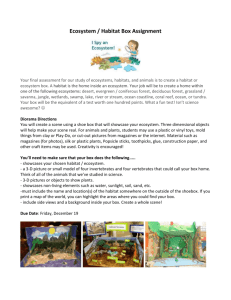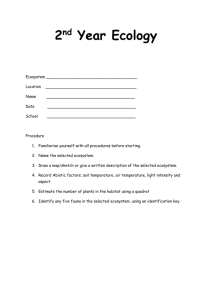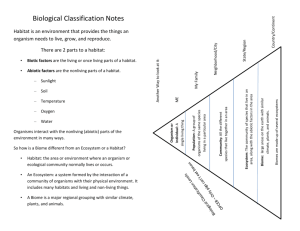Part #3: Ecosystem and Habitat (top half of back panel) – At School

Part #3: Ecosystem and Habitat (top half of back panel) –
At School
Requirements:
1. World Map with the area(s) where your animal lives highlighted in color.
2. Paragraph describing your animal’s ecosystem and habitat.
Directions:
1. Use the Part #3: Ecosystem and Habitat Planning Guide on the next page as you research where your animal lives. This is where you will record the continents on which your animal can be found and you will show its location on a world map. Once you print out the template after you’ve typed your paragraph, outline the areas where your animal lives in pencil first. Then use a colored pencil, crayon, or marker to color in the areas.
You should use the same color for all areas of the world in which your animal can be found.
2. Use the Part #3: Ecosystem and Habitat Planning Guide on the next page as you research where your animal lives. Once you have gathered your information on the planning guide, you will type your paragraph using the
Part #3: Ecosystem and Habitat Template that has been shared with you on Google Docs.
An ecosystem is made up of living and nonliving things that interact in an environment. The four main ecosystems that we learned about in class are: forest, desert, grassland, and aquatic (water) ecosystems. Within these four ecosystems, there are more specific types, such as tropical rainforest or salt water ecosystems.
Within every ecosystem, there are many habitats. A habitat provides a population of living things what they need to survive. For example, a dragonfly can be found in several ecosystems including fresh water.
Within the fresh water ecosystem, the adult dragonfly’s habitat is right around the water. They do not travel far from the water except occasionally while hunting. Your animal’s habitat might be high up in the trees in the rainforest, under rocks on the ground in the African
savanna, or near the bottom of a lake in the temperate forest ecosystem.
Your paragraph should begin with a topic sentence that states what ecosystem your animal can be found in. For example: Dragonflies can be found all over the world including in desert, freshwater, and forest
ecosystems. You should then go on to write supporting details about your animal’s habitat. For example:
Dragonflies can be found all over the world including in desert, freshwater, and forest ecosystems. Immature dragonflies live in freshwater. They are usually found in slow-moving freshwater that has no fish, like in small streams and ponds, but they can be found in many shallow freshwater habitats. Adult dragonflies often stay near water, but sometimes travel away from water while hunting or migrating. They are fast fliers, so they tend to hunt in open areas, not in thick trees or other vegetation. Dragonflies need sunny, warm weather to fly.
If it is too cold or wet, they hide in vegetation. Adult male dragonflies often establish territories along the edges of ponds or streams.
Some information you may want to include about your animal and its habitat in your paragraph could be:
What is the weather or temperature like?
How much rainfall does the ecosystem get?
What kinds of plants grow there?
Where does your animal spend most of it’s time?
Are there any living or nonliving things in your animal’s environment which it needs or with which it interacts frequently? Trees, tall grass, sunlight, water, rocks, soil?
Part #3: Ecosystem and Habitat Planning Guide
1. Where in the world does your animal live? List the continents on which your animal can be found. Then shade the areas in on the world map below.
________________ __________________ _________________
________________ __________________ _________________
2. What type of ecosystem does your animal live in?
______________________
Plan the topic sentence of your paragraph here:
______________________________________________________
______________________________________________________
Now write three facts about your animal’s habitat/ecosystem here:
_____________________________________________________
_____________________________________________________
_____________________________________________________
_____________________________________________________
_____________________________________________________
_____________________________________________________









